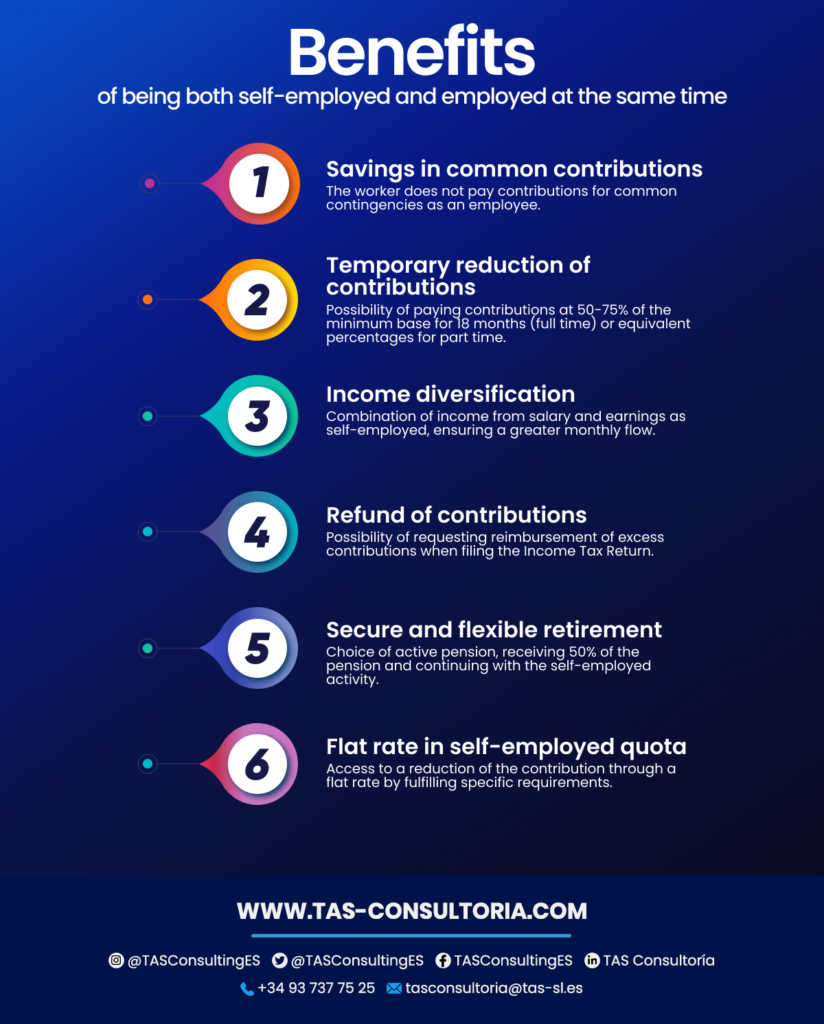
Is being self-employed and self-employed viable in Spain? We explore this labor duality, its advantages and challenges. Find out how these modalities can complement each other. Learn more about this labor option!
Is it possible to be both self-employed and employed simultaneously?
The opportunity to start your own business while maintaining a salaried job with a company is a career option that can present itself in your professional life.
This duality, which involves being self-employed and salaried at the same time, is more common than you might think. And as you might expect, it has implications for social security contributions, the benefits you can access and, of course, the retirement plan you may have in mind.
In this sense, it is essential to understand what this process entails and what actions are allowed in this particular labor scenario. It should be noted that in Spain this situation is provided for and regulated by law, and is known as proactivity.
Within the legal framework, it is possible to run your own business as a freelancer and, at the same time, work as a salaried employee. And no problem, these two work facets can coexist and complement each other in an adequate manner.
It is important to note that, under normal circumstances, there is no risk of losing your employee status by becoming self-employed, nor vice versa. However, you must take into account special situations in which the contract with your employer may establish restrictions in this regard.
You may also be interested in: How to become self-employed in Spain if you are a foreigner?
Benefits of being simultaneously self-employed and employed
There are several advantages associated with being both self-employed and employed simultaneously. It is important to highlight that these benefits would otherwise be unattainable. Below, we detail them for you:

Savings in common contingencies for the self-employed
The employee is not obliged to pay contributions for common contingencies, since these are included in the contributions of the general regime as an employee.
Temporary reduction of contributions
In the case of being self-employed and having a full-time contract. It is possible to contribute at 50% of the minimum base for 18 months and increase to 75% thereafter. For part-time contracts, 75% and 85% respectively, maintaining the same time margins.
Diversification of income sources
The worker does not depend solely on his or her salary as an employee or earnings as a self-employed person. This situation allows combining both sources of income, resulting in a greater monthly flow. In addition, it provides the peace of mind of having a more robust income compared to a single regime.
Reimbursement of excess contribution
By contributing in two different regimes, the worker can request the reimbursement of the excess contribution when filing the Income Tax Return.
Secure and flexible retirement
In relation to retirement, the worker enrolled in both regimes can opt for an active pension, receiving 50% of the pension and continue with his self-employed activity, in addition to receiving at least one pension that reflects the contribution bases as self-employed and employee.
Flat rate in the self-employed quota
Being an employee and being registered as self-employed, the worker is entitled to access the reduction of the quota through the flat rate. However, certain requirements must be met, such as not being the administrator of a company, not having debts with the administration and not benefiting from the temporary reduction of contributions.
You may also be interested in: Beckham Law: A benefit for foreigners in Spain
Is it possible to receive two pensions when I retire?
The Social Security provides incentives for contributing to two regimes simultaneously. This allows self-employed workers to opt to receive two pensions in retirement instead of just one.
However, in order for a self-employed worker who has contributed in both regimes to receive two pensions upon retirement, he or she must meet a crucial requirement: to have contributed for at least 15 years in the General Regime together with the Special Regime for Self-Employed Workers (RETA).
In addition, the self-employed worker must have contributed at least 2 years within the 15-year period immediately preceding the acquisition of the right to the pension.
Therefore, the possibility of receiving two pensions will depend on how your contributions have been and if you have contributed in pluriactivity. Combining self-employed and salaried activity at the same time.
It is essential to emphasize that, in addition to meeting these requirements, the general conditions for accessing the ordinary benefit must be met.
You may also be interested in: How can you register for Social Security?
Now that you have discovered the possibilities of being self-employed and self-employed in Spain, it is essential to have personalized advice. Do you have doubts about your employment situation?
Don’t wait any longer! Request a tax or legal consultation to make informed decisions and ensure your professional success. Our experts are ready to help you at tasconsultoria@tas-sl.es and +34 93 737 75 25.




Your email address will not be published .
Required fields are marked with *